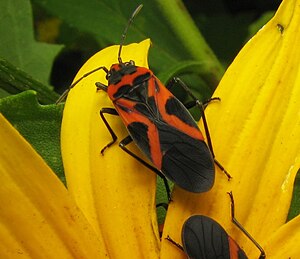Lygaeus turcicus
| Lygaeus turcicus | ||||||||
|---|---|---|---|---|---|---|---|---|

Lygaeus turcicus |
||||||||
| Systematics | ||||||||
|
||||||||
| Scientific name | ||||||||
| Lygaeus turcicus | ||||||||
| Fabricius , 1803 |
Lygaeus turcicus is a bug from the family of ground bugs (Lygaeidae).
features
The bugs become 10–12 mm long. They are dark gray to black in color. Two orange stripes run across the front wings , forming an approximately X-shaped pattern. The clavus is orange in color and only has a black spot at the rear end. The orange head is black in the postocular area. A wide orange transverse band runs over the rear part of the pronotum, which has two black spots on the front edge and two black semicircular areas on the rear edge.
distribution and habitat
Lygaeus turcicus is common in North America. In Canada, the distribution area is in the eastern half. In the United States, they range from California to North Carolina and New England. The species is not represented in the southeast, on the Gulf Coast or in the northwest of the USA.
Way of life
The bugs mainly suckle on the achenes of the garden sun-eye ( Heliopsis helianthoides ), although they can also be grown in the laboratory on the seeds of other plant species. The garden sun-eye also serves as a host plant.
Similar species
The related species Lygaeus kalmii , also found in the United States, looks very similar to L. turcicus . The most important distinguishing feature is the orange colored clavus of L. turcicus , which is black in L. kalmii . In addition, the head of L. turcicus has a much larger proportion of orange. The nymphs of Lygaeus turcicus differ from those of L. kalmii in that the abdomen is uniformly red in color, while bright longitudinal stripes can be seen in the second species.
etymology
It used to be assumed that L. turcicus , like the similar type of bug, L. kalmii, uses silk plants ( Asclepias ) as host and fodder plants. It wasn't until the 1980s that it was noticed that this was not the case. The name False Milkweed Bug , which is commonly used in English, is derived from this fact .
supporting documents
Individual evidence
- ↑ a b c d e f g h Lygaeus turcicus - False Milkweed Bug . www.americaninsects.net. Archived from the original on February 27, 2017. Info: The archive link was inserted automatically and has not yet been checked. Please check the original and archive link according to the instructions and then remove this notice. Retrieved February 26, 2017.
- ↑ a b c d e f Species Lygaeus turcicus - False Milkweed Bug . bugguide.net. Retrieved February 26, 2017.
- ↑ False Milkweed Bug ( Lygaeus turcicus ) . inaturalist.ca. Retrieved February 26, 2017.
- ^ Lygaeus turcicus Fabricius, 1803 . www.discoverlife.org. Retrieved February 26, 2017.
- ↑ a b c James A. Slater (1983): On the Biology and Food Plants of Lygaeus turcicus (Fabr.) (Hemiptera: Lygaeidae). Journal of the New York Entomological Society 91 (1): 48-56. JSTOR 25009340
Web links
- Lygaeus turcicus in the Integrated Taxonomic Information System (ITIS)
